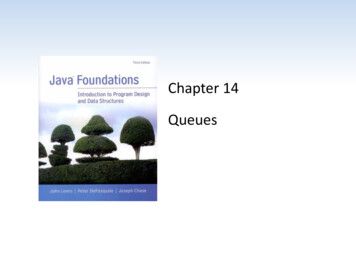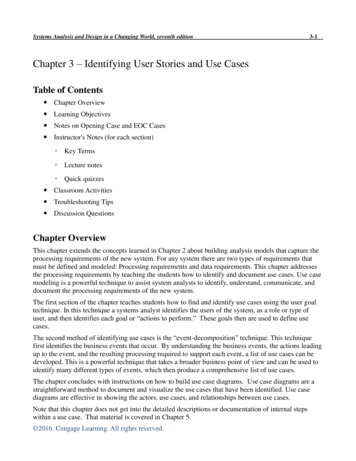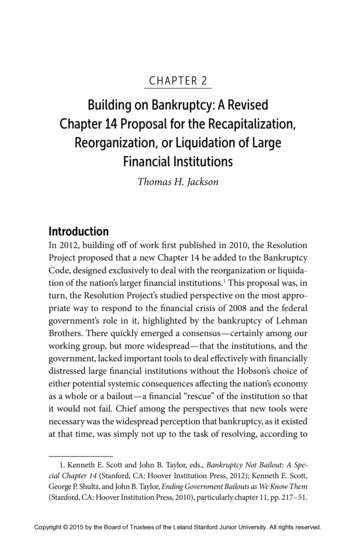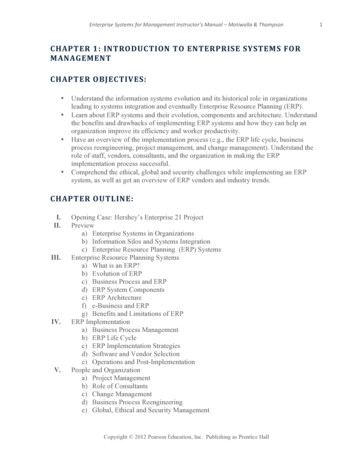
Transcription
Chapter 14Queues
Chapter Scope Queue processingUsing queues to solve problemsVarious queue implementationsComparing queue implementationsJava Foundations, 3rd Edition, Lewis/DePasquale/Chase14 - 2
Queues A queue is a collection whose elements are added onone end and removed from the other Therefore a queue is managed in a FIFO fashion: first in,first out Elements are removed in the same order they arrive Any waiting line is a queue:– the check out line at a grocery store– the cars at a stop light– an assembly lineJava Foundations, 3rd Edition, Lewis/DePasquale/Chase14 - 3
Queues A queue, conceptually:Java Foundations, 3rd Edition, Lewis/DePasquale/Chase14 - 4
Queues Standard queue operations:Java Foundations, 3rd Edition, Lewis/DePasquale/Chase14 - 5
Queues in the Java API The Java Collections API is not consistent aboutits implementation of collections For queues, the API provides a Queue interface,then various classes such as LinkedListimplement the interface Furthermore, the Queue interface defines twoversions of the methods that add and removeelements from the queue The difference in the two versions is howexceptional situations are handledJava Foundations, 3rd Edition, Lewis/DePasquale/Chase14 - 6
Queues in the Java API The add method throws an exception if theelement cannot be added, and the offermethod returns a boolean indicating success orfailure When the queue is empty, the remove methodthrows an exception and the poll methodreturns null The goal is to give the user the option ofhandling exceptional cases in whatever way ispreferredJava Foundations, 3rd Edition, Lewis/DePasquale/Chase14 - 7
Coded Messages Let's use a queue to help us encode and decodemessages A Ceasar cipher encodes a message by shiftingeach letter in a message by a constant amount k If k is 5, A becomes F, B becomes G, etc. However, this is fairly easy to break An improvement can be made by changing howmuch a letter is shifted depending on where theletter is in the messageJava Foundations, 3rd Edition, Lewis/DePasquale/Chase14 - 8
Coded Messages A repeating key is a series of integers thatdetermine how much each character is shifted For example, consider the repeating key3 1 7 4 2 5 The first character in the message is shifted 3,the next 1, the next 7, and so on When the key is exhausted, we just start over atthe beginning of the keyJava Foundations, 3rd Edition, Lewis/DePasquale/Chase14 - 9
Coded Messages Decoding a message using a repeating key:Java Foundations, 3rd Edition, Lewis/DePasquale/Chase14 - 10
/*** Codes demonstrates the use of queues to encrypt and decrypt messages.** @author Java Foundations* @version 4.0*/public class Codes{/*** Encode and decode a message using a key of values stored in* a queue.*/public static void main(String[] args){int[] key {5, 12, -3, 8, -9, 4, 10};Integer keyValue;String encoded "", decoded "";String message "All programmers are playwrights and all " "computers are lousy actors.";Queue Integer encodingQueue new LinkedList Integer ();Queue Integer decodingQueue new LinkedList Integer ();// load key queuesfor (int scan 0; scan key.length; scan ey[scan]);}Java Foundations, 3rd Edition, Lewis/DePasquale/Chase14 - 11
// encode messagefor (int scan 0; scan message.length(); scan ){keyValue encodingQueue.remove();encoded (char) (message.charAt(scan) println ("Encoded Message:\n" encoded "\n");// decode messagefor (int scan 0; scan encoded.length(); scan ){keyValue decodingQueue.remove();decoded (char) (encoded.charAt(scan) - println ("Decoded Message:\n" decoded);}}Java Foundations, 3rd Edition, Lewis/DePasquale/Chase14 - 12
Coded MessagesJava Foundations, 3rd Edition, Lewis/DePasquale/Chase14 - 13
Ticket Counter Simulation Now let's use a queue to simulate the waiting line at amovie theatre The goal is to determine how many cashiers are neededto keep the wait time below 7 minutes We'll assume:– customers arrive on average every 15 seconds– processing a request takes two minutes once a customerreaches a cashierJava Foundations, 3rd Edition, Lewis/DePasquale/Chase14 - 14
/*** Customer represents a waiting customer.** @author Java Foundations* @version 4.0*/public class Customer{private int arrivalTime, departureTime;/*** Creates a new customer with the specified arrival time.* @param arrives the arrival time*/public Customer(int arrives){arrivalTime arrives;departureTime 0;}/*** Returns* @return*/public int{return}the arrival time of this customer.the arrival timegetArrivalTime()arrivalTime;Java Foundations, 3rd Edition, Lewis/DePasquale/Chase14 - 15
/*** Sets the departure time for this customer.* @param departs the departure time**/public void setDepartureTime(int departs){departureTime departs;}/*** Returns* @return*/public int{return}the departure time of this customer.the departure timegetDepartureTime()departureTime;/*** Computes and returns the total time spent by this customer.* @return the total customer time*/public int totalTime(){return departureTime - arrivalTime;}}Java Foundations, 3rd Edition, Lewis/DePasquale/Chase14 - 16
import java.util.*;/*** TicketCounter demonstrates the use of a queue for simulating a line of customers.** @author Java Foundations* @version 4.0*/public class TicketCounter{private final static int PROCESS 120;private final static int MAX CASHIERS 10;private final static int NUM CUSTOMERS 100;public static void main(String[] args){Customer customer;Queue Customer customerQueue new LinkedList Customer ();int[] cashierTime new int[MAX CASHIERS];int totalTime, averageTime, departs, start;// run the simulation for various number of cashiersfor (int cashiers 0; cashiers MAX CASHIERS; cashiers ){// set each cashiers time to zero initiallyfor (int count 0; count cashiers; count )cashierTime[count] 0;// load customer queuefor (int count 1; count NUM CUSTOMERS; count )customerQueue.add(new Customer(count * 15));Java Foundations, 3rd Edition, Lewis/DePasquale/Chase14 - 17
totalTime 0;// process all customers in the queuewhile (!(customerQueue.isEmpty())){for (int count 0; count cashiers; count ){if (!(customerQueue.isEmpty())){customer customerQueue.remove();if (customer.getArrivalTime() cashierTime[count])start customer.getArrivalTime();elsestart cashierTime[count];departs start Time[count] departs;totalTime customer.totalTime();}}}// output results for this simulationaverageTime totalTime / NUM CUSTOMERS;System.out.println("Number of cashiers: " (cashiers 1));System.out.println("Average time: " averageTime "\n");}}}Java Foundations, 3rd Edition, Lewis/DePasquale/Chase14 - 18
Ticket Counter SimulationJava Foundations, 3rd Edition, Lewis/DePasquale/Chase14 - 19
Ticket Counter Simulation The results of the simulation: With the goal of an average time of less thanseven minutes (420 secs), six cashiers will suffice Adding more than eight cashiers will not improvethe situationJava Foundations, 3rd Edition, Lewis/DePasquale/Chase14 - 20
A Queue ADT Defining our own interface for a queue, usingonly the classic operations:Java Foundations, 3rd Edition, Lewis/DePasquale/Chase14 - 21
package jsjf;/*** QueueADT defines the interface to a queue collection.** @author Java Foundation* @version 4.0*/public interface QueueADT T {/*** Adds one element to the rear of this queue.* @param element the element to be added to the rear of the queue*/public void enqueue(T element);/*** Removes and returns the element at the front of this queue.* @return the element at the front of the queue*/public T dequeue();/*** Returns without removing the element at the front of this queue.* @return the first element in the queue*/public T first();Java Foundations, 3rd Edition, Lewis/DePasquale/Chase14 - 22
/*** Returns true if this queue contains no elements.* @return true if this queue is empty*/public boolean isEmpty();/*** Returns the number of elements in this queue.* @return the integer representation of the size of the queue*/public int size();/*** Returns a string representation of this queue.* @return the string representation of the queue*/public String toString();}Java Foundations, 3rd Edition, Lewis/DePasquale/Chase14 - 23
Implementing a Queue with Links Since operations work on both ends of thequeue, we'll use both front and rear referencesJava Foundations, 3rd Edition, Lewis/DePasquale/Chase14 - 24
Implementing a Queue with Links After adding element E to the rear of the queue:Java Foundations, 3rd Edition, Lewis/DePasquale/Chase14 - 25
Implementing a Queue with Links After removing an element from the front:Java Foundations, 3rd Edition, Lewis/DePasquale/Chase14 - 26
package jsjf;import jsjf.exceptions.*;/*** LinkedQueue represents a linked implementation of a queue.** @author Java Foundations* @version 4.0*/public class LinkedQueue T implements QueueADT T {private int count;private LinearNode T head, tail;/*** Creates an empty queue.*/public LinkedQueue(){count 0;head tail null;}Java Foundations, 3rd Edition, Lewis/DePasquale/Chase14 - 27
/*** Adds the specified element to the tail of this queue.* @param element the element to be added to the tail of the queue*/public void enqueue(T element){LinearNode T node new LinearNode T (element);if (isEmpty())head node;elsetail.setNext(node);tail node;count ;}Java Foundations, 3rd Edition, Lewis/DePasquale/Chase14 - 28
/*** Removes the element at the head of this queue and returns a* reference to it.* @return the element at the head of this queue* @throws EmptyCollectionException if the queue is empty*/public T dequeue() throws EmptyCollectionException{if (isEmpty())throw new EmptyCollectionException("queue");T result head.getElement();head head.getNext();count--;if (isEmpty())tail null;return result;}Java Foundations, 3rd Edition, Lewis/DePasquale/Chase14 - 29
Implementing a Queue with an Array If we implement a queue as we did a stack, oneend would be fixed at index 0: The problem is that (unlike a stack) a queueoperates at both ends To be efficient, we must avoid shifting elementsJava Foundations, 3rd Edition, Lewis/DePasquale/Chase14 - 30
Implementing a Queue with an Array A better solution is to treat the array as circular A circular array is a a regular array that is treatedas if it loops back around on itself That is, the last index is thought to precede index0 We use two integers to keep track of where thefront and rear of the queue are at any given timeJava Foundations, 3rd Edition, Lewis/DePasquale/Chase14 - 31
Implementing a Queue with an Array A queue implemented using a circular queue:Java Foundations, 3rd Edition, Lewis/DePasquale/Chase14 - 32
Implementing a Queue with an Array At some point,the elements ofthe queue maystraddle the endof the array:Java Foundations, 3rd Edition, Lewis/DePasquale/Chase14 - 33
After A-H havebeen enqueued: After A-D havebeen dequeueed: After I, J, K, and Lhave beenenqueued:Java Foundations, 3rd Edition, Lewis/DePasquale/Chase14 - 34
Implementing a Queue with an Array Both the front and rear index values areincremented, wrapping back to 0 whennecessaryJava Foundations, 3rd Edition, Lewis/DePasquale/Chase14 - 35
package jsjf;import jsjf.exceptions.*;/*** CircularArrayQueue represents an array implementation of a queue in* which the indexes for the front and rear of the queue circle back to 0* when they reach the end of the array.** @author Java Foundations* @version 4.0*/public class CircularArrayQueue T implements QueueADT T {private final static int DEFAULT CAPACITY 100;private int front, rear, count;private T[] queue;Java Foundations, 3rd Edition, Lewis/DePasquale/Chase14 - 36
/*** Creates an empty queue using the specified capacity.* @param initialCapacity the initial size of the circular array queue*/public CircularArrayQueue (int initialCapacity){front rear count 0;queue (T[]) (new Object[initialCapacity]);}/*** Creates an empty queue using the default capacity.*/public CircularArrayQueue(){this(DEFAULT CAPACITY);}Java Foundations, 3rd Edition, Lewis/DePasquale/Chase14 - 37
/*** Adds the specified element to the rear of this queue, expanding* the capacity of the queue array if necessary.* @param element the element to add to the rear of the queue*/public void enqueue(T element){if (size() queue.length)expandCapacity();queue[rear] element;rear (rear 1) % queue.length;count ;}Java Foundations, 3rd Edition, Lewis/DePasquale/Chase14 - 38
/*** Creates a new array to store the contents of this queue with* twice the capacity of the old one.*/private void expandCapacity(){T[] larger (T[]) (new Object[queue.length *2]);for (int scan 0; scan count; scan ){larger[scan] queue[front];front (front 1) % queue.length;}front 0;rear count;queue larger;}Java Foundations, 3rd Edition, Lewis/DePasquale/Chase14 - 39
/*** Removes the element at the front of this queue and returns a* reference to it.* @return the element removed from the front of the queue* @throws EmptyCollectionException if the queue is empty*/public T dequeue() throws EmptyCollectionException{if (isEmpty())throw new EmptyCollectionException("queue");T result queue[front];queue[front] null;front (front 1) % queue.length;count--;return result;}Java Foundations, 3rd Edition, Lewis/DePasquale/Chase14 - 40
The first character in the message is shifted 3, the next 1, the next 7, and so on When the key is exhausted, we just start over at the beginning of the key Java











